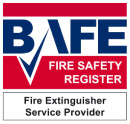29 June 2021
A Guide to Fire Safety in the Workplace
No matter if your business operates out of a small office space or a sprawling industrial complex, it is imperative that fire safety is taken seriously. Fire hazards can be found throughout any workplace, so you must be aware of the particular risks in your premises, how to mitigate them and how to react in the event of a fire. In this article, the team at Fire & Security Group is going to give you a guide to workplace fire safety.

Safe Storage is Crucial
When it comes to storing combustible materials – cardboard boxes, textiles, wood and paper – they should be kept well away from any heat sources and any sources of ignition. All it takes is a stray ember or spark and a box full of uniforms could be set alight, so make sure you don’t store flammable materials in areas where there’s a higher risk of fire, such as kitchens or production areas where sparks are likely.
Make sure you have the proper equipment
Fire safety equipment is one of the most valuable investments you will make. Your building must have fire alarms, smoke alarms and warning systems in place on every floor, and these alarms must be tested regularly to ensure they’re in safe, working order.
You should also invest in fire extinguishers for your building – there are seven classes of fire extinguisher, each one designed to tackle certain types of fire. We’ve written about each extinguisher in detail on our resource centre. It’s important that you have the right type(s) of extinguisher, they’re installed in the right location and that your staff are trained in their safe and proper usage.
Whilst fire extinguishers and alarms are the most common types of fire safety equipment, you should also consider things like dry and wet risers and sprinklers. Dry risers and wet risers are particularly useful for taller buildings, as they allow the fire brigade to access water on higher storeys without having to trail a hose up and around stairs. Sprinklers are highly effective for extinguishing fires over a large surface area.
In addition to active fire protection such as the items mentioned above, you should consider passive fire protection, like fire doors. Fire-rated doors will delay the spread of smoke and fire by up to an hour, buying valuable time for people to escape safely in the event of an emergency. Consult a specialist fire protection company for more information about fire door installation.
Fire Drills are a Must
You should have a clear, effective fire action plan in place, and the best way to ensure it works is to carry out regular fire drills. All staff should be fully aware of your business’ fire emergency procedures, from exit routes to meeting points, and yearly fire drills are the best way to keep everyone up to date. As well as improving knowledge of emergency procedures, fire drills will also help you identify any areas that need improvement, such as cluttered exit routes, poor lighting or inefficient protocols.
Ensure your staff are aware of fire hazards
One of the first lines of defence against fire hazards is knowledge and vigilance. Many workplace fires start as a result of human error or negligence, and those errors often stem from a lack of fire safety knowledge. For example, a person might be unaware of the dangers of overloading a plug socket, and they could leave an extra appliance or two plugged in, which can cause electrical fires.
By arranging for fire safety training for your staff, you can minimise the chance of human error – a reputable company such as Fire & Security Group can provide comprehensive training for all staff that is tailored to your workplace.
You should also appoint fire wardens within your business. The role of a fire warden is to take responsibility for maintaining and updating the business’ fire safety procedures – this includes guiding people through the evacuation process, as well as carrying out fire drills on a regular basis. You can arrange for fire warden training from a reputable fire protection company such as Fire & Security Group.
Carry out Fire Risk Assessments
It is the duty of the responsible person in the workplace to ensure that fire risk assessments are regularly carried out and reviewed. Fire risk assessments are the best way to evaluate your property’s safety and make all-important improvements where necessary. A fire risk assessment doesn’t just identify things like loose wires and faulty fire alarms – it creates a complete picture of every place and person that is at risk. For example, the layout of desks might make it more difficult for people to escape in an emergency, or you may be storing combustible materials too close to heat sources.
By arranging for a fire risk assessment from a qualified company like Fire & Security Group, you can ensure that you’re keeping people safe as well as fulfilling your legal obligations. You should evaluate your fire risk assessment regularly – it’s recommended that you do so once a year.
Workplace fire safety takes a range of forms from equipment to training and awareness. It’s important you don’t take any shortcuts when it comes to any element of fire safety – fire alarms and fire extinguishers are just as important as fire safety training and awareness and fire risk assessments. Fire & Security Group can make your business safer through the implementation of state-of-the-art fire safety equipment, fire safety training and fire risk assessments; contact us today to see how we can help you.

